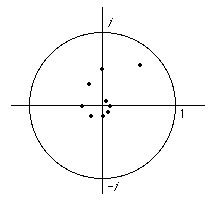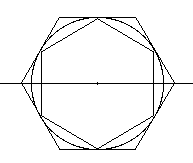Given ε > 0 there exists N ∈ N such that if n > N then we have d(xn, α) < ε.
- For R with its usual metric this is the same as before.
- In C with the metric d(z, w) = |z - w|, consider the sequence (z, z2, z3, ...) with |z| < 1.
Then this sequence converges to 0 ∈ C.
e.g. Take z = (1+i)/2 so that |z| = 1/√2
The points lie on a spiral.
Proof that the sequence converges
Look at the real sequence (d(xn, 0)) = (|zn- 0|) = (|z|n)→ 0 since |z| < 1.

- Look at the sequence in R2 given in the following way.
x1= 2√3, y1= 3 and then define the later terms by 2/xn+1= 1/xn+ 1/yn and yn+1= √(xn+1yn).
This gives a sequence which evaluates numerically to:
( (3.4642, 3.0000), (3.2154, 3.1057), (3.1596, 3.1325), (3.1460, 3.1392), (3.1426, 3.1408), 3.1418, 3.1414), ...)
This sequence is based on the method used by Archimedes to calculate π.
Start with x1= the semiperimeter of the "outside hexagon"
Start with y1= the semiperimeter of the "inside hexagon"
and then double the number of sides to get a 12-gon , a 24-gon, etc.
Archimedes took the calculation up to n = 5 (corresponding to a 96-gon).In fact the sequence in R2 converges to the point (π, π).
Theorem
That is ((x1 , y1), (x2 , y2), ... )→ (α , β) if and only if
(x1 , x2 , ... )→ α and (y1 , y2 , ... )→ β.
Conversely: Given ε > 0 choose N so that if n > N then |xn- α| < ε and |yn- β| < ε. But then √(|xn- α|2+ |yn- β|2) < √(ε2+ ε2) = √2 ε and so we may make this as small as we like.
